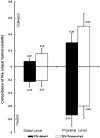Biomechanics of the transverse carpal arch under carpal bone loading
- PMID: 20579787
- PMCID: PMC2919606
- DOI: 10.1016/j.clinbiomech.2010.05.011
Biomechanics of the transverse carpal arch under carpal bone loading
Abstract
Background: Carpal tunnel release and conservative interventions are widely used in clinical therapies of carpal tunnel syndrome. The efficacy of these treatment and interventions mainly lies in the exploitation of the mechanical properties of carpal tunnel. This study investigated the structural mechanics of the transverse carpal arch using cadaveric hands.
Methods: Paired force was applied to the insertion sites of the transverse carpal ligament at both the distal (hamate-trapezium) and proximal (pisiform-scaphoid) levels of the carpal tunnel. The two pairs of forces were simultaneously applied in an inward or outward direction when the transverse carpal ligament was intact and transected. Transverse carpal arch and carpal tunnel compliance in response to the forces were analyzed. Three-way repeated measures ANOVA were used to examine the effect of the transverse carpal ligament status (intact/transected), the level of the carpal tunnel (distal/proximal) and the force application direction (inward/outward) on the biomechanics of the transverse carpal arch.
Findings: Transverse carpal ligament plays a stabilizing role in resisting outward deformation of the carpal tunnel. The carpal tunnel at the proximal level is more flexible than the carpal tunnel at the distal level. The carpal tunnel is more compliant under the inward force application than under the outward force application.
Interpretation: The understanding of carpal tunnel mechanics potentially helps to improve the existing strategies and to develop alternatives for the treatment of carpal tunnel syndrome.
2010 Elsevier Ltd. All rights reserved.
Figures






Similar articles
-
Changes in carpal tunnel compliance with incremental flexor retinaculum release.J Orthop Surg Res. 2016 Apr 13;11:43. doi: 10.1186/s13018-016-0380-3. J Orthop Surg Res. 2016. PMID: 27074707 Free PMC article.
-
Biomechanical role of the transverse carpal ligament in carpal tunnel compliance.J Wrist Surg. 2014 Nov;3(4):227-32. doi: 10.1055/s-0034-1394136. J Wrist Surg. 2014. PMID: 25364633 Free PMC article.
-
Cross-sectional changes of the distal carpal tunnel with simulated carpal bone rotation.Comput Methods Biomech Biomed Engin. 2022 Nov;25(14):1599-1607. doi: 10.1080/10255842.2022.2028143. Epub 2022 Jan 21. Comput Methods Biomech Biomed Engin. 2022. PMID: 35062851 Free PMC article.
-
Carpal Kinematics and Kinetics.J Hand Surg Am. 2016 Oct;41(10):1011-1018. doi: 10.1016/j.jhsa.2016.07.105. Epub 2016 Aug 25. J Hand Surg Am. 2016. PMID: 27569785 Review.
-
Atypical osteochondroma of the hamate that presented clinically as carpal tunnel syndrome: report of an extremely rare case and literature review.BMC Musculoskelet Disord. 2020 Apr 13;21(1):231. doi: 10.1186/s12891-020-03272-8. BMC Musculoskelet Disord. 2020. PMID: 32284050 Free PMC article. Review.
Cited by
-
Biomechanical interaction between the transverse carpal ligament and the thenar muscles.J Appl Physiol (1985). 2013 Jan 15;114(2):225-9. doi: 10.1152/japplphysiol.01273.2012. Epub 2012 Dec 6. J Appl Physiol (1985). 2013. PMID: 23221960 Free PMC article.
-
Volar/dorsal compressive mechanical behavior of the transverse carpal ligament.J Biomech. 2012 Apr 30;45(7):1180-5. doi: 10.1016/j.jbiomech.2012.01.048. Epub 2012 Feb 28. J Biomech. 2012. PMID: 22381735 Free PMC article.
-
In vivo study of transverse carpal ligament stiffness using acoustic radiation force impulse (ARFI) imaging.PLoS One. 2013 Jul 5;8(7):e68569. doi: 10.1371/journal.pone.0068569. Print 2013. PLoS One. 2013. PMID: 23861919 Free PMC article.
-
Changes in carpal tunnel compliance with incremental flexor retinaculum release.J Orthop Surg Res. 2016 Apr 13;11:43. doi: 10.1186/s13018-016-0380-3. J Orthop Surg Res. 2016. PMID: 27074707 Free PMC article.
-
Non-Surgical Carpal Arch Space Augmentation for Median Nerve Decompression.J Biomech Eng. 2023 Aug 1;145(8):080801. doi: 10.1115/1.4056651. J Biomech Eng. 2023. PMID: 36628998 Free PMC article.
References
-
- Agee JM, Mccarroll HR, Jr, Tortosa RD, Berry DA, Szabo RM, Peimer CA. Endoscopic release of the carpal tunnel: a randomized prospective multicenter study. J Hand Surg Am. 1992;17:987–95. - PubMed
-
- Cobb TK, Dalley BK, Posteraro RH, Lewis RC. Anatomy of the flexor retinaculum. J Hand Surg [Am] 1993;18:91–9. - PubMed
-
- Fuss FK, Wagner TF. Biomechanical alterations in the carpal arch and hand muscles after carpal tunnel release: a further approach toward understanding the function of the flexor retinaculum and the cause of postoperative grip weakness. Clin Anat. 1996;9:100–8. - PubMed
-
- Garcia-Elias M, An KN, Cooney WP, 3rd, Linscheid RL, Chao EY. Stability of the transverse carpal arch: an experimental study. J Hand Surg [Am] 1989a;14:277–82. - PubMed
-
- Garcia-Elias M, An KN, Cooney WP, Linscheid RL, Chao EY. Transverse stability of the carpus. An analytical study. J Orthop Res. 1989b;7:738–43. - PubMed
Publication types
MeSH terms
Grants and funding
LinkOut - more resources
Full Text Sources

